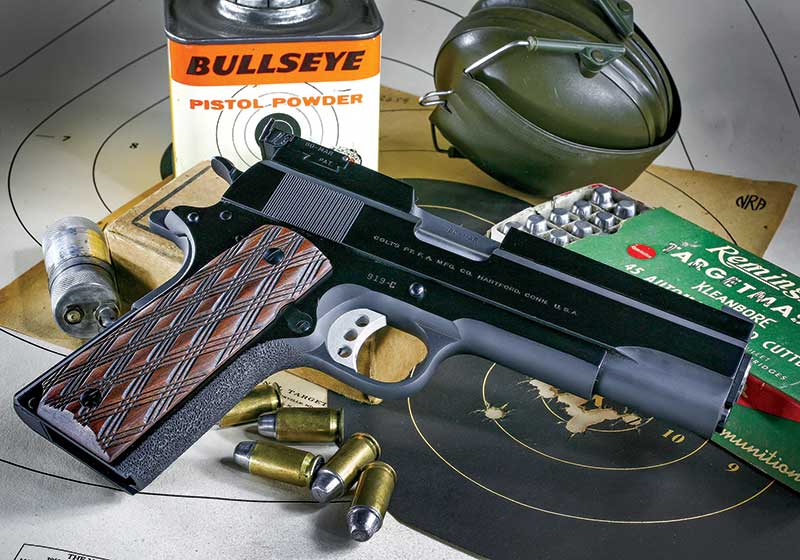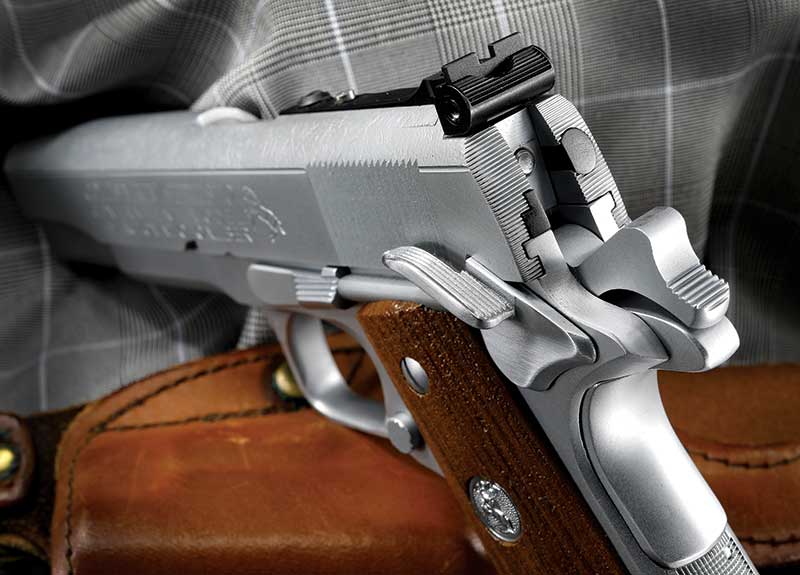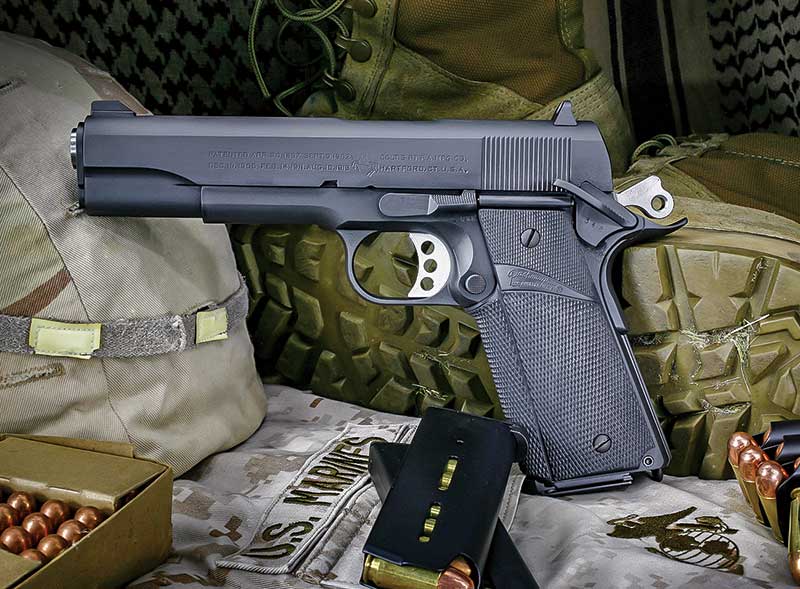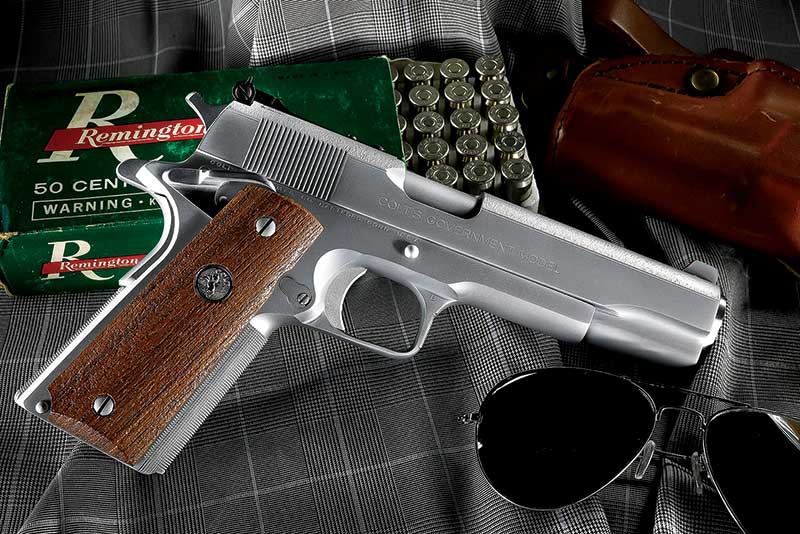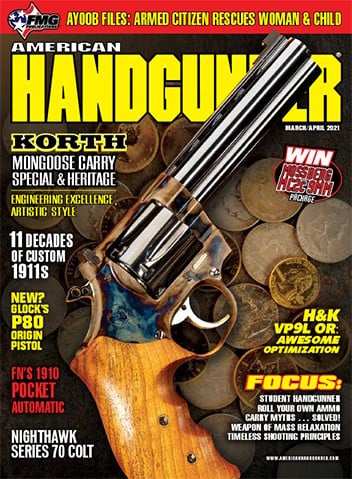Timeless Tradition
The 1911 Through The Decades
The more things change, the more they stay the same. John Moses Browning’s Model 1911 proves it every day. There have been hundreds of new pistol designs patented since the 1911 was accepted by the U.S. Military, but it’s still the most iconic handgun in the United States and beyond.
Four years ago, a client, Mike Gregorski, approached me with a request to build a Colt 1911 in the predominant style for each decade. That’s 11 guns, all .45 ACP Colt 1911s. I didn’t have to think about it — I was all in.
Mike had a few requests. All would be .45 ACP and the original frame and slide had to be from the proper decade. I went to work right away doing research and making a large binder for the 11 different pistols in the project. I scoured the internet for ideas while Mike searched for “unmolested” base guns to serve as blank canvases.
The First Decade
From the outset I knew there would be some decades that would have few modifications to the 1911, like the 1910s. We found a rather nice 1915 Colt US Army, on which I changed a few worn internals. We decided to leave this pistol as original as possible.
Roaring ’20s
The ’20s called for a roaring ’20s “gangster” style gun. Dillinger, Capone and Nitti all wielded the 1911. I started out with a 1921 Colt commercial. I replaced the internals with new bar stock parts made by Extreme Engineering, tightened the slide to frame fit and replaced the old barrel with a new Colt barrel and a custom fit bushing. For the finish I went with satin nickel and nitre blue accent parts to give the gun some flash. The grips are a synthetic mother-of-pearl — the genuine version is too fragile.
’30s
The 1930s saw the first Colt National Match pistols and my client wanted to pay tribute to his dad with a 1936 Colt NM. He found one that had been “bumper chromed.” I stripped the chrome and bought period parts to keep it as close to original as possible. The barrel was pitted, so I replaced it with an unbranded Kart National Match barrel. I acid etched the hood with the proper logos and inspection marks. The slide had fixed sights I machined for an original Stevens adjustable target rear sight and new clone front sight. Carbonia blue is elegant, and we hired Turnbull Restoration to return this 1911 back to like-original condition
World At War: The ’40s
The ’40s saw World War II and the 1911 was produced by the millions as the Allies’ combat sidearm. It’s getting harder to find a nice one, even with the CMP selling off thousands of war-era Colts. Mike found a close-to-original Colt made in 1943 needing a new sear and disconnector. The rear sight was wrong, and the steel trigger was gone. I tightened the slide to frame fit, re-Parkerized, and added clear “Sweetheart” grips — a popular modification by GIs at the time. Rita Hayworth is on one side and the image of the Iwo Jima flag raising on the other.
Postwar ’50s
The post-war ’50s in the U.S. saw shooting sports on the rise and the .45 1911 was now the favorite of NRA Bullseye style shooters at matches like the US Championships, Camp Perry, Ohio. Returning soldiers cast aside old revolvers and turned to the new semi-auto they loved during their service. Thus, began the 40-year era for modifying the Colt 1911.
I wanted to build a traditional bullseye gun with features found on most of the target 1911s of the 1950s. I replaced fixed sights with a High Standard rear sight and a Patridge-style ramped front sight. I tightened the frame and slide and welded up and refit a Colt barrel. I hand stippled the frame front strap with a hammer and punch. Then I honed the sear and hammer to produce a crisp 3.5-lb. break. Last, I added a trigger shoe to the short steel Colt factory trigger.
The ’60s
The ’60s continued to see the NRA Bullseye community push gunsmiths to innovate the 1911 and squeeze out all possible accuracy. Aftermarket parts manufacturers made hundreds of 1911 bits available. BoMar started making dedicated sights and ribs for the 1911, which offered precise adjustment, durability and a longer sight radius. Stippling was still popular.
This build utilized the first generation of the BoMar rib with the removable rear sight. It also featured a Micro bushing and Herrett grips. Tuned to shoot cast lead semi wadcutter bullets at 50 yards, I silver soldered a band of steel on the first locking lug of the barrel, as was the process at the time. Last, I finished this pistol in traditional hot blue.
The Wild 1970s
The ’70s was a wild decade for the 1911. On the west coast, shooters and gunsmiths were pushing more of a practical shooting style and gun. Jeff Cooper and his group of Southwest Combat Pistol League members were making defensive shooting more realistic than ever before. Gunsmiths like Frank Pachmayr, Arnold Capone of Kings Gunworks and Armand Swenson raised the bar with accurate and ergonomic features. The ’70s saw ambi thumb safeties for support hand shooting, magwells for speedy reloads, low profile sights for a snag-free draw and squared trigger guards for two handfed holds.
For this build, I chose to build a Swenson(esk) clone. This would be the most difficult in the series. Armand Swenson was known for a few special features, including a slide top texture to cut down glare and use of the S&W revolver sight. I started with a 70 Series Colt and went with machine checkering on the front strap and MSH for neatness. With the help of my son Nick, we forged the trigger guard square and hand checked it in Armand’s style.
As Swenson did a soldered in a filler piece at the rear dovetail, I had to figure out how to replicate his slide top texture. I asked a few folks for clues on how he did it, and as you might imagine, they were tight lipped. I practiced for about a year on and off with various tools and methods and finally realized after looking at a few originals that there was a lot of variety — Armand didn’t do them all himself. I settled on using a file. The rear sight was something not done a lot today, so I called John Harrison — the last smith I knew who had done one. It required a special cutter of which he only had one, so I had to design a custom cutter for the rear sight slot. It was nerve racking, but I managed to make the cuts without any breakage. Swenson used a custom stud along with the sight tang screw to ensure the sight would not shoot off due to heavy recoil. It also had the owners’ initial punched in it. I finished this pistol in a glass beaded hard chrome and period Colt grips.
The ’80s
In the ’80s the Colt 1911 was still being refined as a practical shooting tool. Smiths like Jim Hogue, Richard Heinie, Charley Kelsey, Bruce Grey and Ted Yost were refining the work of smiths from the ’70s, closing tolerances and adding better finishes. There were also some very wild changes like the work of Jim Boland, which pushed the boundaries to the outer limits of creativity and function.
I went with a Hogue style build. I started with a new Series 80 Colt. The advent of the “Series 80” got a lot of pushback from the shooting community who thought the added safety parts ruined the trigger feel. Many either took them out, or like this example, soldered in a custom plug after removing the new parts from the slide. I again squared and checkered the trigger guard. I fit a new Bar-Sto barrel with a custom bushing and use a replica of the Kings Gunworks grip safety part. I used an ambi Wilson safety to replicate the style of Armand Swenson’s part. It’s finished in hot bluing with hard chrome accent parts.
1990s
The 1990s included fun and games with the 1911 through steel plate shooting and “pin” shooting. This is an event where five bowling pins are placed next to one another, the shooter who can knock down the pins the faster wins. Lots of smiths were making compensators for the 1911 in a variety of calibers, allowing the pistol to stay on target during recoil.
For this project, I sourced a Colt 1991 model and a Clark “Pin Comp” and threaded it to a 6″ Kart barrel. Press check serrations allowed the shooter to show range officers that the gun was unloaded quickly after shooting. A Wilson thumb shield enabled a high two-hand hold without touching the slide during shooting. I chose 10-round Chip McCormack magazines since reloads killed a shooter’s chance of winning. I finished this pistol in hot blue with hard chrome accents and double diamond wood grips.
2000s
In 2001 the world was shaken by the World Trade Center and Pentagon attacks, spawning an offensive not seen since WWII. Front and center was the 1911. The MEU(SOC) Marine Expeditionary Unit-Special Operations Capable M45 1911 was specifically built by USMC armorers for tough combat conditions of Iraq and Afghanistan. The Marines wanted serious knockdown power with the .45 instead of the 9mm M9 Beretta. Built on surplus WWII Colt frames and slides, the MEU(SOC) pistol was equipped with a Bar-Sto match grade barrel, large iron sights, ambi safety and a beavertail grip safety. For my MEU(SOC) clone I added all bar stock internals, beveled the magwell and soldered the front sight for durability. I finished it in IonBond instead of the traditional Parkerizing.
2010s
In 2011, the 1911 turned 100 and still was the choice for many front-line operators. We elected to pay homage to the SWAT teams still relying on the stopping power of the .45 by modeling the Colt Rail Gun — popular with many law enforcement teams. Equipped with a wide funnel magwell, textured VZ grips and a high intensity light, this 1911 is still ready for duty.
Four years, 11 guns, and countless hours of research, gunsmithing and creative problem solving later, Mike has a collection most can only dream of.




